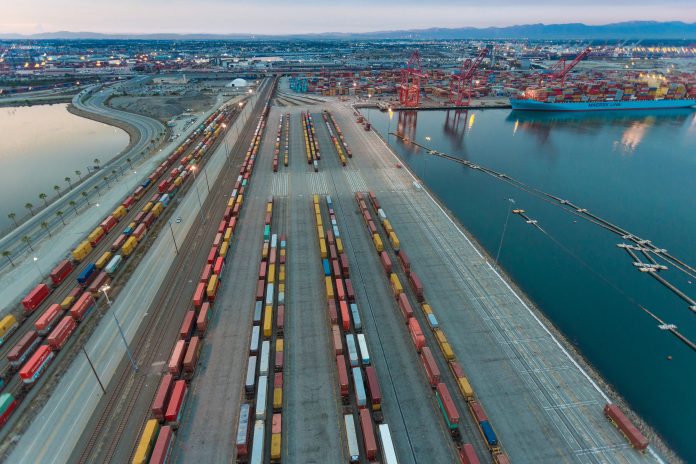On 8 January there were some 35 ships at anchor awaiting a berth at either Los Angeles or Long Beach ports according to Container News sources, with the backlog of freight expected to continue to build through to next month.
[s2If is_user_logged_in()]Stunted rail operations, lack of chassis availability and a shortage of staff across the logistics landscape, mainly due to the spread of Covid-19 throughout the United States, has led to massive delays in shifting import cargo on to its destination and empty containers and exports out of the US.
A Federal Maritime Commission (FMC) investigation is looking into the lack of containers and the alleged failure of carriers to meet export obligations as well as the high, and some claim unwarranted, detention and demurrage charges now being levied by ports and shipping lines.

“Terminals are working with limited labour and split shifts (Covid-19 related). These labour shortages affect all terminals’ turn-around-times (TAT) for truckers, inter-terminal transfers, the number of daily appointments available for gate transactions and generates delays in vessel operations,” said a Hapag-Lloyd customer advisory.
The carrier added that there is also a lack of terminal space due to congestion for operating the vessels. “Dual transactions are encouraged, and the Port Authority is pushing this process to keep freight moving in the complex,” added the German carrier.
Meanwhile, FMC commissioner Daniel Maffei, told a Transportation Club of Tacoma meeting on 12 January, “The pandemic conditions combined with the incredible import volumes, partly resulting from the pandemic, have created a crisis in the supply chain.”
Maffei went on to warn, “We may find that the parameters of Fact Finding 29 are insufficient to address the root of the problems [in the supply chain]. As Commissioner Dye reports back to the Commission, we will explore every action available under our authority.”
According to Maffei, although the commissioners are independent, all five are “of one mind concerning the lack of export containers and the expansion of Commissioner Dye’s brief into unfair practices in detention and demurrage fees.”
Average container turnaround times in China have reportedly increased from 60 to 100 days, “Between this lag, and the lopsided trade balance that results from China exporting three containers for every one returning full, availability of the physical equipment is a major problem,” said Maffei.
“It is not just a US-China issue, though, as there are reports of shortages globally,” he conceded.
“So far, we do not have sufficient evidence that there is any collaborative behaviour or discriminatory conduct. The carriers are handling the situation differently – even if the ultimate result is the same – and the dearth of containers for export does not seem to be tied to any specific type of commodity or individual entity.”
Moreover, the dissemination of containers even to those with contracts is attracting the heightened concerns of the FMC. “What I am hearing about conditions in the industry is upsetting,” said Maffei, “We hear of allotments of containers – seemingly guaranteed in contracts – being cut more than 95% in some cases. We hear of little or no notice being given when expected containers are not made available, making it impossible to get containers even if the exporter is willing to pay a high premium. And we see that there are stacks of empties accumulating at terminals when, at the same time, exporters are begging for them.”
These difficulties are substantially exacerbated by the chronic rail delays at major US ports including delays of 9.1 and 17.8 days on average at Long Beach and Los Angeles respectively.
While sources say the delays through congestion at the following rail terminals are as follows: Rail terminals [T] & rail ramps [R] (imports):
- Halifax, CA – Average 5.9 days (T), 5 days at ramp: total 10.9 days
- Montreal, CA – Average 2.6 days (T), 6.1 days at ramp: total 8.7 days
- Vancouver, CA – Average 2.5 days (T), 12.9 days at ramp: total 15.4 days
- New York, NY – Average 6.1 days (T), 3.1 days at ramp: total 9.2 days
- Charleston, SC – Average 3.2 days (T), 3.2 days at ramp: total 6.4 days
- Savannah, GA – Average 4.9 days (T), 2.8 days at ramp: total 7.7 days
- Norfolk, VA – Average 3.8 days (T), 5.6 days at ramp: total 9.4 days
- Kansa City, MO – 7.2 days (ramp)
- Chicago, IL – 8.1 days (ramp)
- Memphis, TN – 5 days (ramp)
- Council Bluff, IA – 7.4 days (ramp)
- Detroit, MI – 6 days (ramp)
Chassis Pools:
Chassis availability issues are being encountered in Oakland – Minneapolis – Omaha – Cincinnati – Cleveland – Detroit – Louisville – Pittsburgh – Dallas – Tampa – Philadelphia – New York – Dallas – Baltimore – Los Angeles / Long Beach.
These delays and the detention and demurrage issues, as well as other issues resulting from the pandemic moved commissioner Maffei to say, “perhaps it is time that Congress take a hard look at whether the law covering ocean shipping – mostly written more than a third of a century ago – adequately addresses the modern realities of the shipping industry. The current law was written in an era when it was assumed that the marketplace could resolve most problems and there were more than two dozen common carriers competing.”
In conclusion, Maffei said, “Both Congress and we at the FMC should consider the lessons learned in this current crisis and make sure the Shipping Act is made robust enough to accomplish its stated purposes – not the least of which is promoting American exports.”[/s2If]
[s2If !is_user_logged_in()]Please login or register to read the rest of the story[/s2If]
Nick Savvides
Managing Editor







